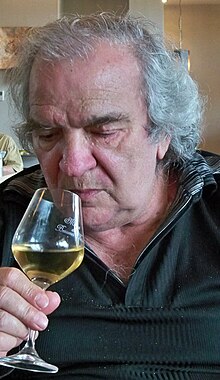 |
| Mental Healthy on a study showing red wine is good for you. |
The best introductions to wine are probably those written by Hugh Johnson. (I'm not saying that because we went to the same college, honest.) You can carry his pocket book of wine discreetly and look up wines in it under the table, tricking the sommeliers into thinking you are a fellow oenophile to make them bring you out choicer bottles of the mellow red.
 |
| Available from Waterstones |
Jancis Robinson writes a regular column in the FT Weekend on wines but these are usually surprisingly affordable, not material for providing background to some lush den of vice in which young people are about to be pleasured or punished in ways they never imagined. A good source of notes on how different vintages of wine taste, with background details on the vineyards, is the Wine Doctor. Personally, I rely on the Larousse Encyclopedia of Wine. It has a helpful section on matching food to your wine as well as chapters explaining how to choose a decanter and what glass to use for which wine.
 |
| The Cathedral in Reims, Champagne central. |
Okay, now. Wine and food. Wine should almost always be drunk with food, the exception being champagne in the UK. (The French drink champagne with food.) This is one of my favourite stories about wine and food:
 |
| Drink Château d'Yquem at Otto et Mezzo BOMBANA when passing through Shanghai |
The guests, horrified, waiting for the chef to fling his apron at the floor and storm out. But the chef smiled, spread his arms with a gallic shrug and said:
"The Prince knows, that for the wine to be good, the food must be perfect."
 |
| Royal Northern College of Music canapés |
Champagne will not go with red meat. (I'm still boggle-eyed that the indie writer LaRascasse managed to create a villain so lost to decency that he drank a flute of champagne with beef ravioli.)
 |
| From The EmBot blog |
Bond: Red wine with fish. Well that should have told me something.
Grant: You may know the right wines, but you're the one on your knees.
Red meat and red wine are where the real gourmet stuff happens.
 |
| Available from Casa Martinez |
 Reds are the wines which get the loving careful treatment with the decanter. This used to be in order to ensure that crusted sediments which accumulated in the bottle as the wine aged could be strained out. Nowadays, different wine-making techniques mean very few red wines have any deposit but many people still decant red wines (and sometimes whites) in order to encourage them to 'breathe'. Most wines taste much better with a bit of oxygen to get them going. You can cheat if you forget to open your bottle half an hour/an hour beforehand by pouring the wine from high up into the glass so it bubbles a bit. (Do not do this to a Lafite Rothschild!) One red wine which must be drunk as soon as it's uncorked is the Chateau Musar, a peculiarly tasty Lebanese wine which becomes peculiarly disgusting if allowed to breathe.
Reds are the wines which get the loving careful treatment with the decanter. This used to be in order to ensure that crusted sediments which accumulated in the bottle as the wine aged could be strained out. Nowadays, different wine-making techniques mean very few red wines have any deposit but many people still decant red wines (and sometimes whites) in order to encourage them to 'breathe'. Most wines taste much better with a bit of oxygen to get them going. You can cheat if you forget to open your bottle half an hour/an hour beforehand by pouring the wine from high up into the glass so it bubbles a bit. (Do not do this to a Lafite Rothschild!) One red wine which must be drunk as soon as it's uncorked is the Chateau Musar, a peculiarly tasty Lebanese wine which becomes peculiarly disgusting if allowed to breathe.  |
| Dégustation à Beaumes-de-Venise Fr.wikipedia.org |
As we erotica writers say: bottoms up!
No comments:
Post a Comment